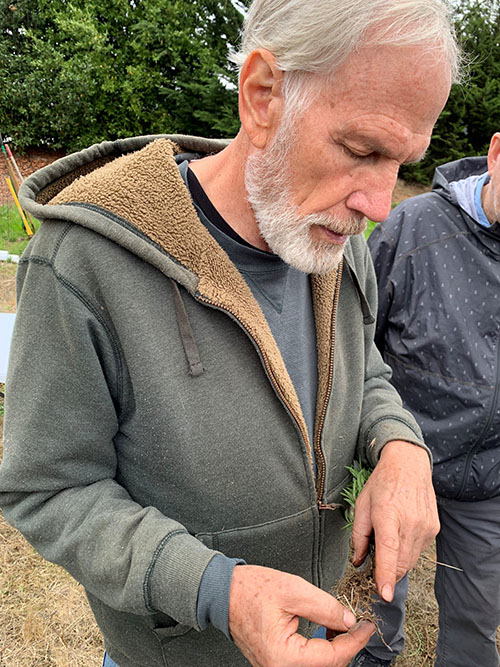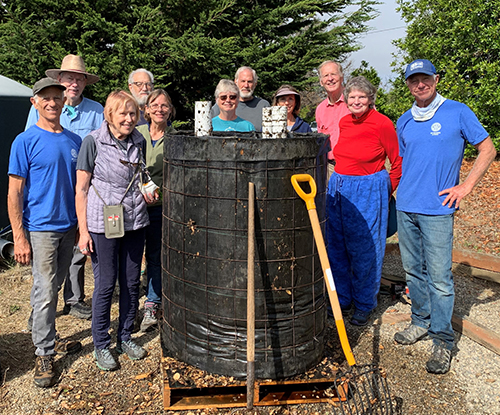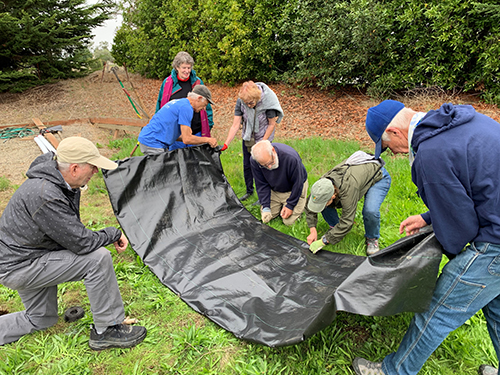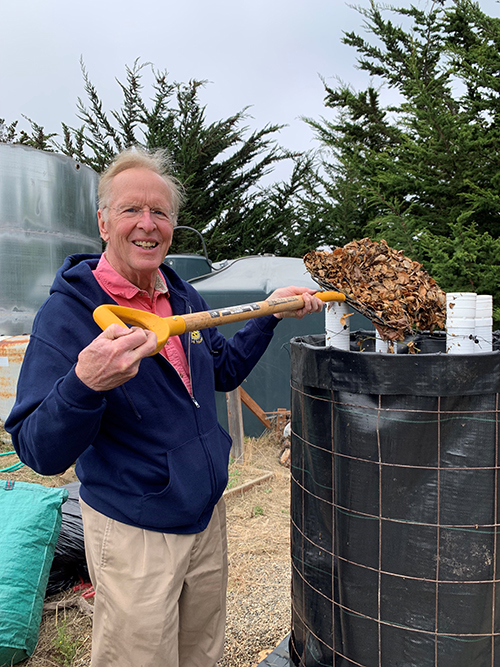Don Maruska pitches a forkful of the wet leaves, hay, and horse manure mixture that will feed the fungi in the bioreactor built on the property at St. Benedict’s Episcopal Church in Los Osos.
As world leaders convene in Glasgow, Scotland this month to tackle climate change, a local group is working toward improvements at home. A group of folks met at St. Benedict’s Episcopal Church in Los Osos to make a positive environmental impact that goes beyond curbing energy use via efficient appliances or driving less.
“We are in a climate crisis,” said volunteer Project Manager Don Maruska, a member of St. Benedict’s Episcopal Church and its EarthCare Team. “While many people and governments are wringing their hands about what to do about climate change, we can take action right now in our communities. Trees and plants have been removing CO2 from the atmosphere for eons; working with nature we can improve climate health.”
Scientistic consensus states that there is too much CO2 in the atmosphere caused by oil, coal, and other fossil fuels being burned for energy. This excess has led to global warming.

To learn how they could make a difference, members of the church’s Earthcare and Landscape teams, Rotary Club de Tolosa, Los Osos Valley Garden Club, and Rotary Passport Club met with Tim LaSalle, Ph.D., professor emeritus at Cal Poly College of Agriculture and co-founder of the Center for Regenerative Agriculture and Resilient Systems. The goal of the meeting was to build a simple bioreactor on the church’s property that would feed and concentrate naturally occurring mycorrhizal fungi.
Mycorrhizas are beneficial fungi growing alongside plant roots that increase the plant’s ability to absorb more nutrients and water from the soil. They also increase plant tolerance to different environmental stresses, which would increase yields and crop quality, improve drought tolerance, help control soil erosion, and maintain soil quality and nutrient cycling.

Photos courtesy of St. Benedict’s Episcopal Church
“We want to boost the productivity of our soils and their ability to convert CO2 into living carbon in the roots of trees and plants,” said Maruska. “This will enable our congregation to support a program to plant 30 trees on the property and other efforts that tap nature’s ability to solve our climate crisis.”
A bioreactor is a simple structure that is a little larger than a standard garbage can. It uses dried leaves, aged horse manure, dry hay, and other natural materials and a watering system which keeps it moist for 12-14 months. The process allows naturally occurring mycorrhizal fungi to grow. Food scraps are avoided because they don’t provide a good nutrient source for the fungi.
Unlike compost piles, which breakdown plant material with an anaerobic process, the bioreactor is aerobic or air-based. This means that a well-functioning bioreactor does not create odors or attract pests. It costs less than $300 for the materials to make one.
The bioreactor works well in a setting where the concentrated product can have multiple uses. While readers can build home bioreactors, Maruska suggests sharing the product with other properties.
The big question is whether bioreactor technology can make a significant impact in problems like loss of sea ice, accelerated sea level rise and longer and more intense weather events.

“Yes,” Maruska said. “The bioreactor effort is part of a larger movement to support regenerative agriculture. That means agriculture that keeps our soils alive (and holding carbon) with no-till or low-till techniques. As noted in the documentary “Kiss the Ground” (available on Netflix), if half of U.S. agriculture used these practices, it could remove all of the excess CO2 in the atmosphere. We need to get people aware and acting to make this possible.”
The mycorrhizal fungi created using the bioreactor will be used to accelerate the growth and carbon-capturing capacity of the St. Benedict’s planned 30-tree orchard. Additionally, the Climate Action Team from Rotary de Tolosa plans to build additional bioreactors to benefit tree planting and other projects in San Luis Obispo.
The church’s EarthCare team is actively involved in the organization’s efforts to be good stewards of creation.
“It has active members from our congregation and others in the community who want to learn and take action together,” said Maruska. “We’ve led book discussions, held Earth Day services, and created a Beginner’s Guide to Creation Care and the Climate Crisis. All events are free and open to the public.
“We want our example to inspire other faith-based communities, service clubs, and commercial agriculture to see how aligning with nature offers practical solutions to the climate crisis.”
For more information about EarthCare resources and activities at St. Benedict’s Episcopal Church, go to www.StBensLosOsos.org. More information about regenerative agriculture is available at CSU Chico’s Center for Regenerative Agriculture and Resilient Systems at csuchico.edu/regenerativeagriculture.




